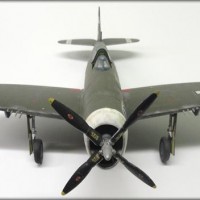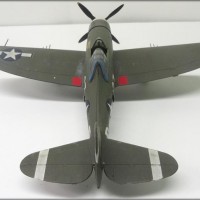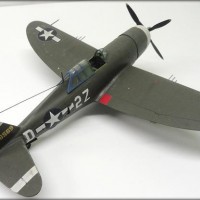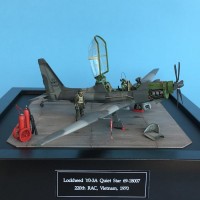1/48 Scale Monogram P-47D (Razorback)
The Monogram P-47 Razorback has always been an impressive model to me, good detail for the time, without any of the toy like action of earlier kits. Plus, it is a Thunderbolt! Next to the B-25H, this is one of my favorite aircraft of all time.
In the Beginning
Opening up the box, as stated above, I discovered that there are really not too many pieces to assemble on this kit, especially on a kit this size. This molding is an original one from 1977, and it has the raised panel lines that are classic Monogram. This kit parts are all molded in Olive Drab. In addition to the usual fuselage, and wings parts, you also get 2 500lbs bombs, as well as a 200 gallon "paper" belly tank, and the "Bazooka" type rocket launchers. After all the parts were looked, over the fun began.
Construction
The construction began as usual with the cockpit and internal areas. The cockpit for this kit has some pretty good out of the box detail, which includes the cockpit tub itself, a stick, seat, and if you wish, a pilot. The details on these pieces are molded as part of the piece that they are on, but the detail is very good. I began by painting the tub, seat, and interior fuselage parts that would be visible Interior Green. After all this was dry, I gave the whole cockpit tub a black wash to pop out some detail.
While the cockpit tub was drying, I cut the fuselage and wing pieces from their trees. The wing halves went together well with no mold or sink marks in them, in fact the whole model had almost not mold or sink marks at all. At this time, I also removed and painted the engine block, which is only the front face showing the cylinder heads, cooling vanes, and magnetos, but looks ok. The fuselage halves were scrapped and sanded on the mating edges, and after the cockpit tub and engine block had been installed, were glued together.
After this was done, I glued the completed fuselage and wing sections together, and then the puttying began. Even though I had scrapped and test fitted the mating surfaces, there was a fair amount of puttying to do, especially on the wing roots. I then attached the stabilizers to the tail, and installed the tail wheel assembly to the airframe. The areas that needed a fair amount of putty were the lower fuselage and the upper wing root, where it meets the fuselage. The stabilizers need a little bit, but not much. For putty, I used automotive body filler, and utilized the Nail Polish remover method to "sand" down the putty. Everything went good for the putting stage, so I went to stage two.
Painting
After washing the model to get rid of all the residue from the seam work, I let the model dry, then the painting began. I first painted the lower areas of the aircraft Neutral Grey (ANA 603). The wheel wells, as well as the tail wheel section were painted Zinc Chromate. After letting these colors dry for a day or so, I painted the upper surfaces Olive Drab (ANA 613). I then proceeded to make a soft edge wave line between the two colors utilizing my Q tip method. This was the first time I had made a soft edge wavy line, and it came out not looking to bad. After all was judged to be in order, it was off to give this bird a personality.
Decals
I decided to try a new method of glossing up the paint for decals by sponge brushing on Future floor wax on all surfaces that where going to have decals on them. After the wax, had dried, I used decals from an aftermarket decal sheet from the Eagle Strike American Jabos, sheet #48035, since the original ones that came with the model were no longer usable.
I had very little problem with the decals, except for the name of the aircraft on the nose area. The name on the nose art is two different decals, the main art work and the shadow for the words in the art work. It took a while, but I finally got it right.
There were quite a few data block type decals, as well as warning decals for various areas on the aircraft. All these other decals went down well. The decals then got the Microsol and Microset treatment. After letting the decals dry for a few days, I sealed the decals again with Future, sponge brushed on.
Weathering
The Olive Drab that was used on USAAF aircraft based in England had a strong tendency to weather, mainly due to the lovely English weather, so I lightened the upper surfaces of this kit. I used a wash of RLM 22 White to fade the upper surfaces of the wings and fuselage. I then added paint chipping and peeling by using Flat Aluminum paint on the wing, tail, and propeller leading edges, as well as cockpit entry areas and ordnance loading areas for the wing guns. After this part was done, I laid down a coat of Dullcote to seal in all paint and decals.
After the Dullcote had dried, I did a wash of Grimy Black over the whole model. After this wash was dry, I added fuel stains on fuel filler caps and drop tanks, as well as exhaust stains to the underside where just behind the engine exhaust outlets. A very light dry brush of Mud was added to tires and the underside of the aircraft near the tail wheel.
Final Assembly
At this point I am painting the evil canopy lines. I paint the canopy lines Interior Green first, then the decal instructions called for a dark to medium blue color for the outside canopy framing. I elected to use just standard old acrylic Blue for the outside color. After the Interior Green was dry, I painted the blue color over the interior green. Even though it covers the green on the outside, it looks like the green was painted on the interior part of the framing.
After the evil canopy was painted, and attached with white glue, I did some small paint touch ups that I thought needed to be done, as well as painting the landing gear oleos bright silver. After that, I put on the antenna wire, painted it black, and put the finished product on the shelf.
Conclusions
For a kit with so little actual parts to it, the finished product looks impressive, as well as making into a pretty big model. The overall fit was not bad, considering that the molds are well over 25+ years old. This kit also has a lot of the same components that the earlier Bubbletop issue P-47 that Monogram did in the 1960's, which means you get a lot of extra parts for the parts box in the form of Bazooka tubes and bombs. The one big issue that I will not do again was use Future floor wax for decal prep. It took months for the glossy shine to fade out, and it looked odd, even under a coat of Dullcote. From then on, it was Glosscote all the way!
Until next time…








Nice P47 The old monograms are hard to beat. I built many a B 25. I wish I still had them but I got rid of most of my old kits as I had no space for them.
Very nice!
Great review & details of a classic kit!
Great looking Thunderbolt!
very nice. Great article also.
My all time favorite radial...I like it. 🙂
Nice looking Jug. A classic kit that's a quick and fun build.
Looks like you scored a hit with this one, Kip.